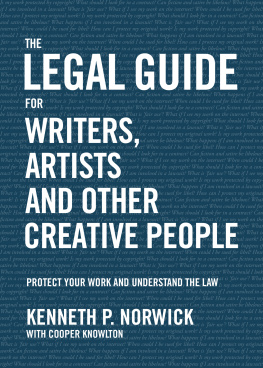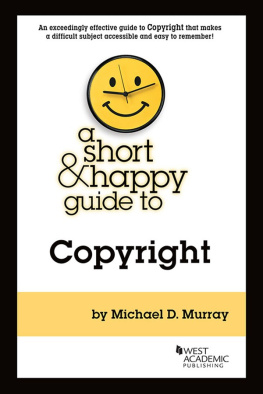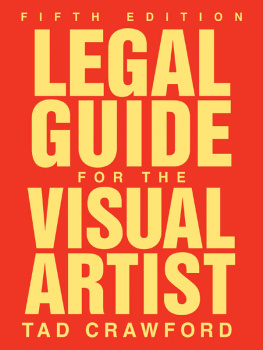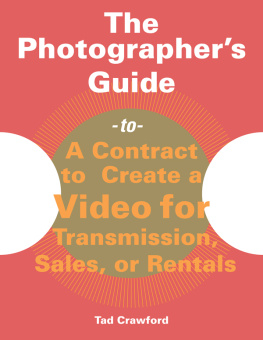THE CREATIVE ARTISTS LEGAL GUIDE
THE CREATIVE ARTISTS LEGAL GUIDE
COPYRIGHT, TRADEMARK, AND CONTRACTS IN FILM AND DIGITAL MEDIA PRODUCTION
BILL SEITER & ELLEN SEITER

This book is designed to assist film and other media makers confront the legal challenges posed by todays media environment. We do not guarantee that the legal information is complete or up-to-date, nor do we wish to suggest that this legal information is a substitute for personalized legal advice. We recommend that you consult a lawyer if you want advice regarding your specific circumstances.
Copyright 2012 by Bill Seiter, Ellen Seiter, and Yale University.
All rights reserved.
This book may not be reproduced, in whole or in part, including illustrations, in any form (beyond that copying permitted by Sections 107 and 108 of the U.S. Copyright Law and except by reviewers for the public press), without written permission from the publishers.
Yale University Press books may be purchased in quantity for educational, business, or promotional use. For information, please e-mail sales.press@ yale.edu (U.S. office) or sales@yaleup.co.uk (U.K. office).
Designed by Mary Valencia.
Set in Sabon and Eureka Sans types by Integrated Publishing Solutions.
Printed in the United States of America.
Library of Congress Cataloging-in-Publication Data
Seiter, William J., 1953
The creative artists legal guide : copyright, trademark, and contracts in film and digital media production / Bill Seiter, Ellen Seiter.
p. cm.
Includes bibliographical references and index.
ISBN 978-0-300-16119-9 (alk. paper)
1. Intellectual propertyUnited States. 2. Copyright and electronic data processingUnited States. 3. Digital mediaLaw and legislationUnited States. 4. CopyrightUnited States. 5. Trademarks Law and legislationUnited States. 6. CopyrightFictitious charactersUnited States. 7. ContractsUnited States. 8. Fair use (Copyright)United States. I. Seiter, Ellen, 1957 II. Title.
KF2979.S45 2012
346.730482dc23 2011052838
A catalogue record for this book is available from the British Library.
This paper meets the requirements of ANSI/NISO Z39.481992 (Permanence of Paper).
10 9 8 7 6 5 4 3 2 1
To our sister Rose
PREFACE
Students and professionals in film and media arts today encounter a continuous feed of breaking news about intellectual property. Cutting-edge legal developments, deals, and disputes revolving around copyright, trademarks, and rights of privacy and publicity are reported daily in the most sensational terms. Aspiring filmmakers witness a spectacle of legal happenings involving litigators and lobbyists, First Amendment Davids and big-business Goliaths, record-breaking deals and contracts gone sour. This endless pageant could remain a tale of sound and fury signifying nothing to youthe creative artistuntil you get a solid grip on the core legal concepts.
The Creative Artists Legal Guide is here to help students and teachers, creative entrepreneurs, and professionals cut through the clutter and meet head-on the intellectual property challenges posed by todays complex media environment. It will empower you to understand what questions to ask and what situations to avoid. Our book demystifies the law that surrounds film, animation, video games, and new media so that when your turn comes to dealing with the lawyers, agents, executives, and other players who trade in IP and business law all day long, seven days a week, you will deal with confidence.
What must you do to copyright your screenplay? How do you clear rights for your latest film project? Is there a way to steer clear of legal trouble while producing a mockumentary about a bodybuilder turned movie star turned governor turned gossip-page headliner? How do you figure out whether a vintage novel is in the public domain? How do you determine whether a cool-sounding trademark you dreamed up for your production company is available? Do those cute woodland creatures you storyboarded for your new cartoon come too close for comfort to Bambis pals? What types of contracts must you sew up to stitch together your transmedia storytelling project across multiple platforms? How will you defend yourself if a famous brand objects to your unorthodox depiction of their trademarked product in your artwork? How do you nail down copyright and trademark rights overseas to be able to reach foreign audiences and markets?
This comprehensive user-friendly guide explains intellectual propertyits roots, internal logic, and regional variationsapplied to fiction, screenwriting, various forms of filmmaking from celluloid to digital, animation, video gaming, and other creative media.
walks you through the ins and outs of copyrights: how to get them, how to protect them, how to deal in them, how to fight with them, and how to take them abroad.
does the same for trademarks, so different from copyrights, yet vital to creative content branding in your media-rich world, and to the commercial mechanics of everything from film financing to celebrity endorsements to video gaming to merchandise licensing to social networking sites and mobile content distribution.
probes the pitfalls that lurk within the rules of the game laid down by schools, guilds, and studios, rules that can take away or limit your rights in the work you create, so that you can approach the institutions that may make or break you with eyes wide open.
pilots you through the swamp waters of entertainment and other media-driven contracts, as you negotiate the transmedia epic of a lifetime with a cast of hungry industry crocodiles.
explains rights of publicity and privacy, and the importance of taking them into account at the front end of your media productions.
rounds out the tour with a look at the laws and legal structures governing the Internet and new media, and the ways copyright, trademark, and other concepts mapped out in the first five chapters affect the genesis, distribution, and protection of creative works in a virtual world.
By arming the content creator with practical legal information and career guidance, this book will help you protect your work from those seeking, sometimes unfairly, to profit from it. Potential profiteers run the gamut from teachers, employers, internship supervisors, and talent agents to amateur copycats and professional counterfeiters, to the many outfits that require you to surrender your IP rights if you want to play in their sandboxfrom social networking, virtual reality, and other user-generated content sites to universities, studios, and other media producers, large and small.
By immersing you in emergent issues in law and media studies, The Creative Artists Legal Guide will also supply you with the tools you need to operate as a savvy digital citizen, a politically informed artist, and a global sophisticate in the new media universe.
We come to this book as a pair of siblings with three decades of experience along parallel professional paths: Bill as a lawyer specializing in copyright, trademark, business, and international law; Ellen as a professor, researcher, and widely published critic in film, television, and new media studies. Our education in film began in the 1960s at the second-run Roxy Theater in Pacific Beach, California, where on Friday nights our mother would take us, along with brothers Frank and Charles and sister Rose, to marvel at the art and artistry of Sergio Leone and Clint Eastwood, Ennio Morricone and Nino Rota, Elizabeth Taylor and Jean Simmons, Kirk Douglas and Robert Mitchum, Burt Lancaster, Sidney Poitier, Sophia Loren, Federico Fellini, and Akira Kurosawa.
Next page







